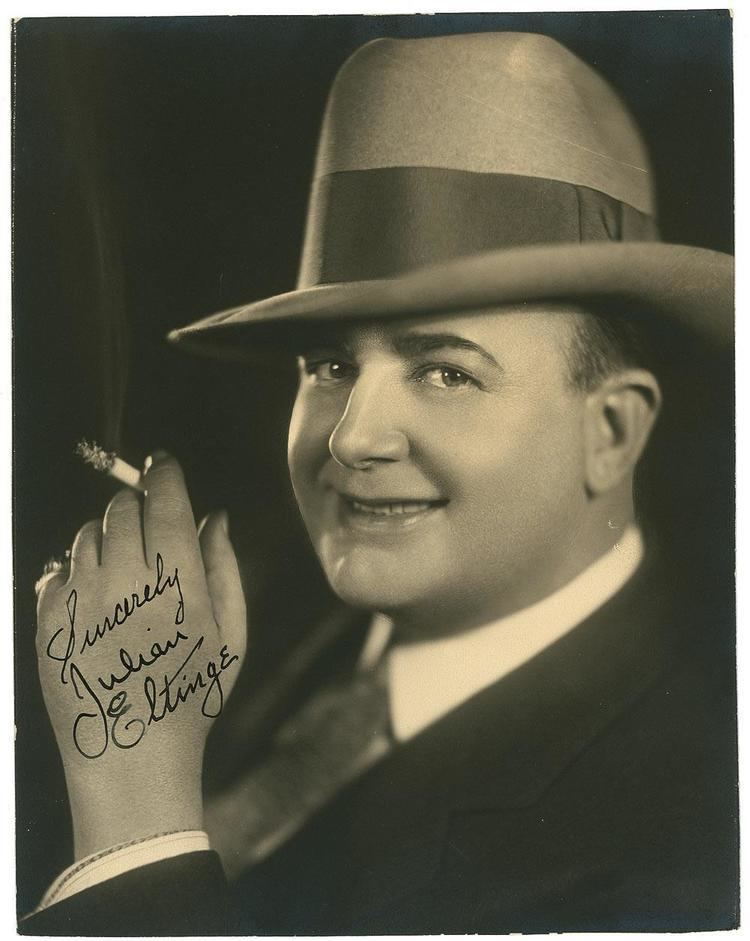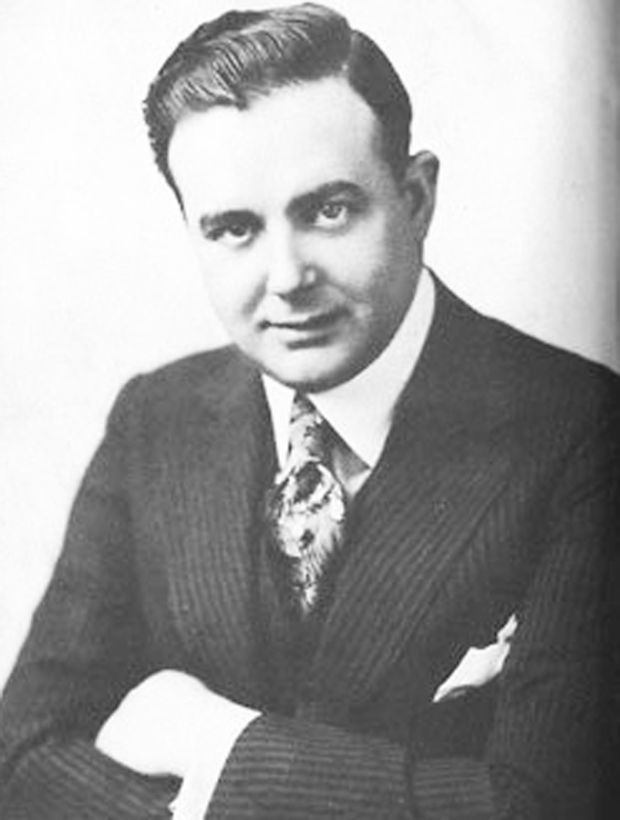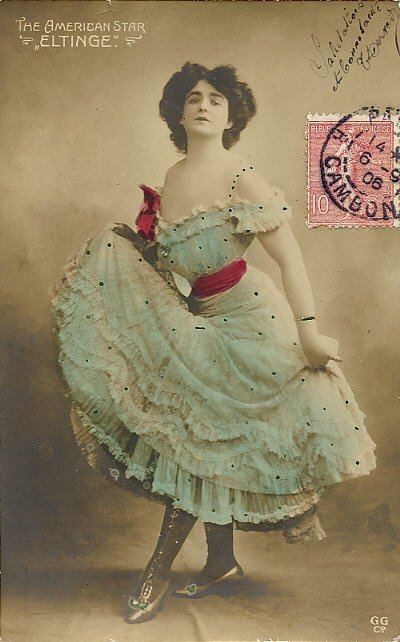Cause of death Cerebral hemorrhage Role Actor | Name Julian Eltinge Resting place Forest Lawn Memorial Park | |
 | ||
Full Name William Julian Dalton Occupation Actor, female impersonator Movies The Isle of Love, The Countess Charming, Madame Behave, The Widow's Might, The Clever Mrs. Carfax Parents Julia Edna Baker, Joseph Dalton Similar People Donald Crisp, Fred J Balshofer, William C deMille | ||
Julian eltinge female impersonator on the voice of hollywood 1929
Julian Eltinge (May 14, 1881 – March 7, 1941), born William Julian Dalton, was an American stage and screen actor and female impersonator. After appearing in the Boston Cadets Revue at the age of ten in feminine garb, Eltinge garnered notice from other producers and made his first appearance on Broadway in 1904. As his star began to rise, he appeared in vaudeville and toured Europe and the United States, even giving a command performance before King Edward VII. Eltinge appeared in a series of musical comedies written specifically for his talents starting in 1910 with The Fascinating Widow, returning to vaudeville in 1918. His popularity soon earned him the moniker "Mr. Lillian Russell" for the equally popular beauty and musical comedy star.
Contents
- Julian eltinge female impersonator on the voice of hollywood 1929
- Julian Eltinge Documentary
- Early years
- Broadway and vaudeville
- The Fascinating Widow and beyond
- Hollywood and film career
- Personal life
- Later years and death
- In popular culture
- Quotations
- Filmography
- References

Hollywood beckoned Eltinge and in 1917 he appeared in his first feature film, The Countess Charming. This would lead to other films including 1918s The Isle of Love with Rudolph Valentino and Virginia Rappe. By the time Eltinge arrived in Hollywood, he was considered one of the highest paid actors on the American stage; but with the arrival of the Great Depression and the death of vaudeville, Eltinge’s star began to fade. He continued his show in nightclubs but found little success. He died in 1941 following a show at a New York nightclub. He leaves a legacy as one of the greatest female impersonators of the 20th century.

Julian Eltinge Documentary
Early years
Though the details of his professional life are widely known, Eltinge's personal life is shrouded in mystery; mystery partly due to the passage of time, but really more likely to Eltinge's own hand. Eltinge was born in Newtonville, Massachusetts(some sources narrow it just to Boston) to Julia Edna Baker and Joseph Dalton. It is believed that his father was a mining engineer and that early in his life he traveled out west with his father, ending up in Butte, Montana. In his early teens, Eltinge dressed in women's clothing and performed in the rugged saloons patronized by ranchers and miners. Upon discovering this in 1899, his father beat him and his mother sent him back to Boston, where the 17-year-old worked in dry goods as a salesman while studying dance.

His start in show business, like his early life, is also shrouded in myth. Most sources cite his first female role originally having been at the age of ten with the Boston Cadets Review at the Tremont Theater in Boston. He is reported to have played the role so well that the next year the revue was written around him which led to minor roles elsewhere. But as to how he came to perform as a female a decade later with the Boston Cadets, sources differ. In some versions he was taking cakewalk lessons from a Mrs. Wyman's dance studio when he impressed upon his teacher an incredible ability to emulate females. It is said to be Mrs. Wyman who encouraged young William to study the art of female impersonation. Boys often play female roles in all male theater groups.
Broadway and vaudeville

Eltinge's first appearance on Broadway was in the musical comedy Mr. Wix of Wickham which opened September 19, 1904 at the Bijou Theatre in New York City. The show was produced by E. E. Rice and included music by Jerome Kern among others. The show was a flop, but it helped to establish Eltinge as a rising star.
During this time Eltinge began performing in vaudeville. Unlike many of the female impersonation acts that existed at that time, like Bert Savoy or George Fortesque, Eltinge did not present a caricature of women but presented the illusion of actually being a woman. He toured simply as "Eltinge" which left his sex unknown and his act included singing, dancing and quick costume changes in a variety of female roles, including a Gibson Girl-like role called "The Sampson Girl". At the conclusion of his performances, he would remove his wig, revealing his true nature to the surprise of the often unknowing audience.
In 1906 Eltinge made his London debut at the Palace Theater. While in London, Eltinge was commanded to give a performance for King Edward VII, who later presented him with a white bulldog. The next year, Eltinge made his New York debut at the Alhambra Theater to critical acclaim. From 1908 to 1909 Eltinge toured with Cohan and Harris Minstrels.
Eltinge's star began to shine on Broadway and on national tours and his name became known worldwide. Indeed, women were so enthralled by his performances that he established the Eltinge Magazine which advised women on beauty, fashion, and home tips.
By 1910, Eltinge had reached the height of his fame. Sime Silverman, Editor of Variety, called him "as great a performer as there is today".
The Fascinating Widow and beyond
In 1911, Eltinge opened one of his most famous shows, The Fascinating Widow at New York's Liberty Theater. In it he played Hal Blake who disguises himself as "Mrs. Monte" in a Charley's Aunt-like plot. The show only ran 56 performances in New York, but toured the nation successfully for several years.
The success of this show led producer A. H. Woods to give Eltinge one of theatre's highest honors, having a theatre named for him. A year to the day that The Fascinating Widow opened, Woods opened the Eltinge Theatre on New York's 42nd Street designed by noted theater architect Thomas W. Lamb. Eltinge himself never performed in his namesake building. After serving as a legitimate theater for many years, it became a notorious burlesque house and was shut down during a "public morality" campaign in 1943, before becoming a cinema the next year. The theater is now part of the AMC Empire 25 cineplex having been lifted and moved in its entirety down the block from its original location.
Following on the success of The Fascinating Widow, Eltinge performed in two other comedies that had similar success, The Crinoline Girl which opened in 1914 and Cousin Lucy (with music by Kern) the next year.
Hollywood and film career
As many actors began to leave for the silver screen, Eltinge followed and in 1914 he starred in silent picture versions of The Crinoline Girl followed by Cousin Lucy the next year. According to Anthony Slide's The Encyclopedia of Vaudeville, he also had a cameo role in a film entitled How Molly Malone Made Good in 1915. Eltinge's first real screen success came in 1917 in The Countess Charming. His role in the film was again a double role with him playing both a male and said male in female garb.
Settling in Hollywood, Eltinge made three films in 1917 and also in 1918. During this time he wrote and produced a vaudeville group called "The Julian Eltinge Players". With this group he returned triumphantly to the vaudeville stage appearing at New York's Palace Theatre in 1918, where he was paid one of the highest salaries in show business: $3,500 a week. The next year he returned again in a new vaudeville review with sets by the French designer Erte.
By 1920, Eltinge was very wealthy and was living in one of the most lavish mansions in Southern California, Villa Capistrano. His star began to shine even brighter after his appearance with Rudolf Valentino in the 1920 film An Adventuress (released as The Isle of Love in the U.S.). After filming, Eltinge continued touring onstage and would do so until 1927. He also made two films, Madame Behave and The Fascinating Widow, in 1925.
Personal life
Aside from the graceful femininity he exhibited onstage, Eltinge used a super-masculine facade in public to combat the rumours of his homosexuality. This facade included the occasional bar-fight, smoking cigars, and drawn out engagements to women (though he never married). He was also known to physically attack stagehands, members of the audience and others who remarked on his sexuality. Indeed, his sexual duality led to Dorothy Parker's creation of the term "ambisextrous" to describe him.
Eltinge may have been a gay man, as Milton Berle and many others who worked with him believed. Actress Ruth Gordon stated in a New York Times article that he was "as virile as anybody virile." There is no existing record of a lover of either sex, though stories did abound. According to one such story recorded by Robert Toll in his book On With the Show! (1976), Eltinge gave a photograph of himself as Salome, signed "From your friend Jule", to a Boston sportswriter. When the sportswriter's wife discovered the photograph in her husband's coat pocket she was outraged. Confronting her husband, she had to be convinced that the "woman" in the photograph was actually a man, but however she was disturbed to find that her husband had been spending time with him.
Later years and death
Eltinge was one of many show business figures to be hit hard by the 1929 stock market crash. By the 1930s, the female impersonations that he had built his career on had begun to lose popularity, as did vaudeville in general. Eltinge himself had grown portly and unable to portray the svelte young female roles of his heyday. Eltinge resorted to performing in nightclubs. Crackdowns on cross-dressing in public, a misguided attempt to curb homosexual activity (cross-dressing is predominantly a heterosexual activity), prevented Eltinge from performing in costume. At one appearance in a Los Angeles club, Eltinge stood next to displays of his gowns while describing his old characters.
On May 7, 1941, Eltinge fell ill while performing at Billy Rose's Diamond Horseshoe nightclub. He was taken home and died in his apartment ten days later. His death certificate lists the cause of death as a cerebral hemorrhage.
In popular culture
A reference to Julian Eltinge is found in Buster Keaton's comedy Seven Chances (1925). In the film, Keaton's character must marry before 7:00 PM in order to receive a large inheritance. After many failed attempts to find an instant bride, he sees a poster with a woman's photo outside a performance hall and, in an act of desperation, enters to ask for her hand in marriage. While Keaton is inside, a stagehand removes some boxes to reveal the woman's name on the poster: Julian Eltinge. Keaton then emerges from the theater with a black eye and his boater hat smashed down over his head.
In Vincente Minnelli's 1953 film The Band Wagon, Fred Astaire's character finds that the Eltinge theater has been converted into a penny arcade, and there he performs one of his most famous song-and-dance sequences, singing "Shine on Your Shoes."
In Lenny Bruce's comic monologue, "The Palladium," about a comic failing at the famous London music hall, the house manager suggests the comic sneak out in disguise: "I believe Julian Eltinge left a wig here in the closet many years ago."
Quotations
My heart is simply melting at the thought of Julian Eltinge;His alter ego, Vesta Tilley, too.
Since our language is so dexterous, let us call them ambi-sexterous -
Why hasn't this occurred before to you?Dorothy Parker, "A Musical Comedy Thought" - Vanity Fair, June 1916W.C. Fields remarked that "Women went into ecstasies over him. Men went into the smoking room."
